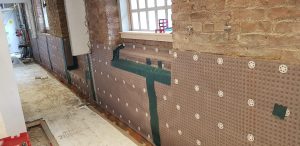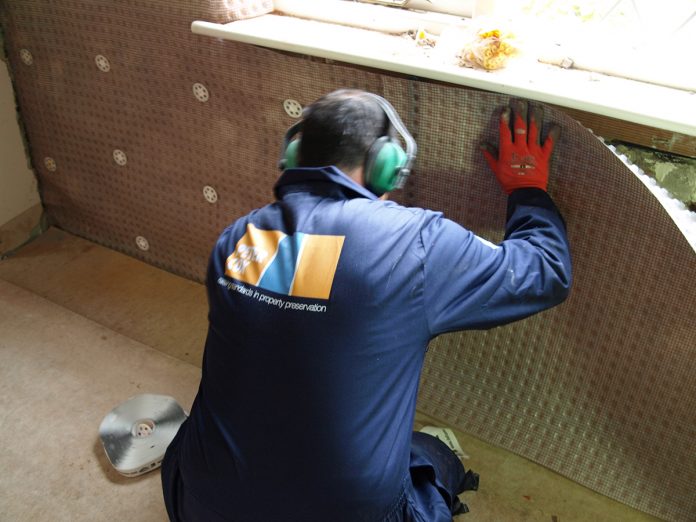Mike Jones, national waterproofing manager at Peter Cox, looks at the key issues to consider in order to deliver a successful basement conversion
When additional space is required, it can often be worth exploring the opportunity of digging down to expand your premises with a basement conversion. This could add significant value to your property, especially in inner city areas where buildings are increasingly limited in regard to available and developable land space.
Basement conversions can be an attractive and far more cost-effective alternative to buying or building a new space, but they can also be massive projects to manage successfully.
Structural waterproofing is a critical part of any below ground build or conversion project and very often, it’s the difference between success and failure. The Chartered Institute of Building states that 75% of building failure is the result of water ingress – with failures leading to mould, corrosion or other moisture-related problems such as dry rot, and even serious structural problems.
Peter Cox was recently called to work on a historic building in West Yorkshire, which was being extended to include below ground habitable space. The original contractor installed a Type A Barrier Protection System, which had been incorrectly installed, meaning it hadn’t successfully bonded with the new concrete walls. This meant the entire site had to be re-excavated and the system installed again, but this time correctly. This led to an unforeseen cost to the client, which could have been mitigated if the project had been managed correctly in the first place. Peter Cox was then awarded the contract and installed an effective solution that met the required industry standards.
Following correct building protocols should ensure that costs do not escalate out of control. The National House-Building Council (NHBC) consistently reviews its guidance and requirements around structural waterproofing. Although the NHBC standards do not have direct relevance to commercial builds, it is worth considering their recommendations as best practice. For example, Chapter 5.4 of its published standards makes it clear that any waterproofing project must include early input from a waterproofing design specialist and build on the recommendations of BS 8102;2009.
What you need to know about BS 8102;2009
BS 8102;2009 offers a guide to the different waterproofing options and combinations available. It specifies three grades of protection, based on building use.
Some seepage and damp areas are tolerated in Grade 1 builds, such as car parking facilities or plant rooms. In Grade 2 builds, such as workshops or storage facilities, water penetration is not acceptable, but moisture vapour is tolerated. Finally, habitable spaces, which fall into Grade 3, must be a completely dry environment. Grade 3 not only includes offices and living spaces, but it can also relate to areas of storage – where easily damaged goods such as clothes and food are stored.
Get advice early
The best thing to do is to get a qualified Certified Surveyor in Structural Waterproofing (CSSW) involved in any new build or conversion project. Not only is it the best way to minimise risk, but also they will help you to lever down the costs of waterproofing – which can often be a large proportion of the total project cost. Early planning will enable your surveyor to tailor the waterproofing design to your construction type, rather than having to tailor it around other committed build considerations.
Types of waterproofing
In any below ground space that falls into Grade 3 and/or high-risk environments, at least two different types of waterproofing systems should be used. This is not only practical advice, but also is in line with the NHBC’s standards. BS 8102 categorises the types of waterproofing systems as:
Type A: This provides a barrier against groundwater and water ingress by surrounding the external walls, floor and roof with a waterproof material – literally creating a barrier between water and the structure. This can be applied either internally or on the building’s exterior.
Type B: Relies upon the design and materials incorporated into the external shell of the structure itself. Structures that provide Type B protection should be constructed of reinforced water-resistant concrete or structural steel.
Type C: Involves adequately disposing of water, either by gravity or through a sump and pump to a suitable outlet. This must be designed with adequate access points for servicing and maintenance, with a one-way valve to prevent backflow. Type C systems use a cavity allowing water to reach the drain, while being protected by an internal lining, with all joints and junctions correctly lapped and sealed.
Each has its own pros and cons. For example, while Type C waterproofing will require ongoing maintenance, it is much easier to identify and fix any problems that might arise. However, they all share one common characteristic in that retrofitting is extremely expensive, disruptive and difficult, if not impossible in some cases.

Final words
Given the complexity of waterproofing a building, a design specialist should always be involved as early as possible. While compliance with waterproofing standards can be expensive, getting the process wrong can lead to the building’s structural integrity being compromised and therefore it will cost you far more in repair and damages. If you are unsure of the correct approach to waterproofing then it’s always best to get in touch with the experts.
Peter Cox has a network of branches across the UK with numerous CSSW-qualified surveyors and trained technicians, meaning we are able to complete waterproofing projects to an exceptionally high quality, meeting industry standards. We are members of the British Structural Waterproofing Association (BSWA) and are a founder member of the Property Care Association (PCA).
Visit: https://www.petercox.com/specialist-expertise/waterproofing-tanking/.
Peter Cox Ltd
Tel: 0808 1208737
Twitter: @petercox1951
*Please note: this is a commercial profile.





![[Video] Fireco: 80 new fire doors required for residential flats in London](https://www.pbctoday.co.uk/news/wp-content/uploads/2025/04/2024-06-01-Lords-view-one_1200x750_004-218x150.webp)








